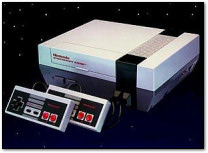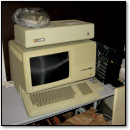September 13th, 2010 by Benj Edwards
 “Play slots anywhere you go without the expense!”
“Play slots anywhere you go without the expense!”
I believe I bought this Radio Shack LCD Mini Slot Machine unit at a hamfest back in the 1990s. The game broke not too long afterward, but I apparently kept the box and the manual.
Fast forward 15 years later. I recently discovered the box in a pile of my old stuff at my parents’ house. After flattening the box, I scanned the whole thing so you can create your own tiny three dimensional reproductions of it at home (if you’re into that Radio Shack diehard papercraft thing). Heck, fill a whole room with them and dive in!
[ Radio Shack LCD Mini Slot Machine box, 1994 ]
Discussion Topic of the Week: Did you (or do you) ever own any Radio Shack electronic games? Which ones?
Posted in Electronic Toys, Gaming History, Regular Features, Retro Scan of the Week, Retrogaming | 3 Comments »
September 13th, 2010 by Benj Edwards

10 years ago today, Apple released the Mac OS X Public Beta. It was the general public’s first chance to experience the new OS and the commercial debut of the software (a previous release, confusingly named “OS X Server,” was based on a pre-OS X prototype called Rhapsody).
The Public Beta sold for $29.95, and Apple offered that amount off the purchase of OS X 10.0 for those who bought the Beta.
I’ve always been a fan of OS X, and this anniversary got me wondering how development on this very innovative OS started. After some digging, I wrote a brief history on the origins of OS X for Macworld. I was fortunate to have the help of Avie Tevanian, former VP of Software Engineering at Apple (1997-2006), as a reference to help me get some points straight.
While I was at it, I also wrote a shorter piece about some of the differences between the Public Beta and Snow Leopard (the most recent version of OS X).
What are your thoughts on OS X? Do you use it? Did you use it? Let us know in the comments.
Posted in Computer History, Macintosh, News & Current Events, Vintage Computing | 8 Comments »
September 13th, 2010 by Benj Edwards

Super Mario Bros. turned 25 years old today.
I first played this NES masterpiece when I was about six years old — around late 1986 or early 1987. I remember visiting the house of my brother’s friend, venturing upstairs and seeing a futuristic grey box attached to his TV set. There, on the screen, unfolded an astoundingly magical, enchanting, mysterious, and captivating world of mushrooms, flying turtles, and flowers that imbued your character with the power of fire.
What enchanted me the most (aside from the fantastically whimsical setting) was the fact that Nintendo had packed the game with secrets like invisible blocks, hidden extra men, and — my god — warp zones. Us kids had even heard rumors of the Minus World, which prompted joyful quests to uncover every mystery of the game.
 Before the NES, video games to me meant Atari 800 and 2600, which I had seen my older brother playing throughout my early youth. I loved them, sure, but Super Mario Bros. simply blew my mind. It was nothing, and I mean nothing, like that which had come before. SMB elevated video games to an entirely new plane of existence in terms of its worldview and philosophy of play. For the first time, I truly felt like I was visiting another land — and living out an alternate life — in a video game.
Before the NES, video games to me meant Atari 800 and 2600, which I had seen my older brother playing throughout my early youth. I loved them, sure, but Super Mario Bros. simply blew my mind. It was nothing, and I mean nothing, like that which had come before. SMB elevated video games to an entirely new plane of existence in terms of its worldview and philosophy of play. For the first time, I truly felt like I was visiting another land — and living out an alternate life — in a video game.
For folks born after 1990 or so, what I’ve written above may seem like a load of hyper-inflated flowery language. But it’s very hard to exaggerate the impact that Super Mario Bros. — a game that sold 40 million copies — had on the video game industry, on the cultural world at large, and on the lives of an entire generation. It was that important.
You Tell Me
So now I turn to you. What are your memories of Super Mario Bros.? When did you first play the game and how did you feel about it?
Posted in Gaming History, NES / Famicom, News & Current Events, Retrogaming | 13 Comments »
September 13th, 2010 by Benj Edwards

25 years ago today, Nintendo released Super Mario Bros. for the Famicom in Japan. In honor of this anniversary, I decided to dive into the depths of Super Mario lore and legend.
I surfaced clutching 13 examples of Mario-related weirdness, which I conveniently packaged in a slideshow format for Technologizer. The result is Super Mario Oddities, a gallery in the same vein as my Game Boy Oddities piece from last year. I hope you enjoy it.
Posted in Gaming History, NES / Famicom, News & Current Events, Retrogaming | 8 Comments »
September 10th, 2010 by Benj Edwards

The Internet’s first search engine, Archie, launched 20 years ago today. To celebrate this occasion, I decided to look back at the early days of many search engines (mostly web) of the past 20 years. The resulting slideshow is up on PC World.com for all to see. I hope you enjoy it.
Posted in Computer History, Internet History, News & Current Events, Vintage Computing | 9 Comments »
September 6th, 2010 by Benj Edwards
 Apple IIc and the Apple Flat Panel Display
Apple IIc and the Apple Flat Panel Display
I’ve always loved this cover shot. It bursts with vivid, colorful photography of a particularly beautiful Apple IIc.
“Particularly,” I said, because this Apple IIc is not in its usual configuration. It sports a rare and wondrous peripheral known as the Apple Flat Panel Display, an LCD monitor which initially sold for $595 (that’s about $1,205 in 2010 dollars) in 1985.
Despite being Apple’s first LCD display, the device sold poorly. Here’s why: For one thing, it was way too expensive for what you got. And what you got wasn’t that great. Sure, it displayed 80 columns by 24 lines and even high resolution graphics, but in a bizarrely squat screen ratio. In a 1985 review of the monitor, Infoworld wrote, “…characters displayed on the Flat Panel Display have the same oddly stretched appearance of writing on a fat man’s T-shirt.”
The same review notes how difficult it was to read the non-backlit display under any lighting conditions — bright light, dim light, direct light, etc. The combination of intense glare and low contrast made the monitor uncomfortable to use. Mix those elements together, and you have yourself a recipe for a genuine ahead-of-its-time Apple flop: innovative, but not quite ready for prime time yet. Sound familiar?
Still, I’d love to get my hands on an Apple Flat Panel Display and report my experiences directly to you. If anyone out there has one that they’d like to get rid of, please let me know.
[ From Popular Computing, June 1984, cover ]
Discussion Topic of the Week: When did you first use a computer with an LCD screen? When (if ever) did you switch to using LCD screens on your desktop PCs?
Posted in Computer History, Regular Features, Retro Scan of the Week, Vintage Computing | 13 Comments »
September 2nd, 2010 by Benj Edwards

 Mona Lisa (c. 1503-1506) by Leonardo Da Vinci
Mona Lisa (c. 1503-1506) by Leonardo Da Vinci
An image like this should be familiar to early Macintosh users, since the first Macs only supported 1-bit color. That is, two colors total: each pixel could be black or white — on or off — and nothing in between. The image above uses only black and white and a dithering effect to trick your brain into perceiving shades of grey. Somehow, it makes me feel warm and fuzzy inside.
Update: Hover over the image to see 1-bit Mona Lisa rendered with Floyd-Steinberg error diffusion, which is another algorithm for converting color images to black and white.
Posted in Art, Computer History, Macintosh, Regular Features, Vintage Computing | 8 Comments »
August 30th, 2010 by Benj Edwards
 Origin’s Times of Lore for the Commodore 64
Origin’s Times of Lore for the Commodore 64
[ From Compute’s Gazette for Commodore Users, December 1988, p.5 ]
Discussion Topic of the Week: What’s your favorite computer RPG of all time? Any year, any computer platform.
Posted in Computer Games, Regular Features, Retro Scan of the Week, Retrogaming | 20 Comments »
August 23rd, 2010 by Benj Edwards
 “Press <CR> for more”
“Press <CR> for more”
For my sixth grade social studies class, I wrote a report on Mikhail Gorbachev, former President of the Soviet Union. And he really was “former” then — the USSR had fallen apart just two years prior to my report in 1991. For that report — which I ran across recently — I used every resource available to me, including a novel one at the time: Grolier’s Encyclopedia on CompuServe Information Service. My family subscribed to CompuServe — that massive, pre-ubiquitous-Internet dial-up service that cost amazingly large fees an hour — and I loved it.
What you see above is part of the Gorbachev encyclopedia entry in the form of a dot-matrix printout from the DOS version of CompuServe Information Manager (a front-end client for CompuServe) that I printed myself. Various lines are crossed out and underlined, noting areas of interest that I was to paraphrase for the report. This wasn’t plagiarism — I even cited the online encyclopedia in my report’s bibliography. That fact is actually kinda impressive to me in retrospect.
CompuServe’s online encyclopedia was amazing at the time (1992-1993 era). It was so easy to just search for a term, look it up, and print it out. It sure beat our family’s musty 1968 World Book Encyclopedia set that I used for every report prior to this one (yes, the information in my reports was often woefully out of date). For Christmas 1993, my dad bought us Microsoft Encarta on CD-ROM, and that served as the meat of my school reports for the next few years after that. But that’s another story entirely.
[ From Grolier’s Academic American Encyclopedia (CompuServe printout), 1993 ]
Discussion Topic of the Week: When did you first use an electronic encyclopedia — CD-ROM or otherwise? What did you use it for?
Posted in BBS History, Computer History, Regular Features, Retro Scan of the Week, Technology Commentary, Vintage Computing | 11 Comments »
August 19th, 2010 by Ulaf Silchov

SOME PEOPLES ASK ULAF THIS: HOW IS IT THAT MY MIND CAN CAPTURE THE SPEED? TO WHICH ULAF RESPAWN A SIMPLE WORDS: WITH THE SPEEDBOARDS OF COURSE. IT IS TRUE THAT THE SPEED OR THE BOARDS HAVE BEEN HARDEST TO TAME OF ALL ELEMENTS, SO THE MAGIC OF THESE DEVICE CANNOT BE UNDERSTOOD.
SO THEN ALWAYS RECALL THIS DAY THAT HERE YOUR MIND SEES THIS SPEEDBOARDS PHOTOGRAPHY, ONE PICTURES OF THAT ULTIMATE MASTER DEVICES FOR THE NINTENDO ENTRAPMENT SYSTEM (NES FOR ABBREVIATED). ULAF USE IT AND USE IT, THEN OBTAIN HIGHEST SCORE EVER DURING MEGA MEN II WITH FINGERTIPS. NO SMALL FEET.
JUST A QUICK NOTE FROM MY MIND. GO BACK TO LIFE NOW. UNTIL NEXT TIME THIS IS ULAF SAYING BE THE MASTER.
—
Ulaf Silchov is an expert in video games and computers. He also writes for “Svadlost Weekly” and “The Almost Perfect Circle Newsletter.”
Posted in Gaming History, Humor, NES / Famicom, Regular Features, Retrogaming, Ulaf Silchov | 5 Comments »
 “Play slots anywhere you go without the expense!”
“Play slots anywhere you go without the expense!”

 Before the NES, video games to me meant Atari 800 and 2600, which I had seen my older brother playing throughout my early youth. I loved them, sure, but Super Mario Bros. simply blew my mind. It was nothing, and I mean nothing, like that which had come before. SMB elevated video games to an entirely new plane of existence in terms of its worldview and philosophy of play. For the first time, I truly felt like I was visiting another land — and living out an alternate life — in a video game.
Before the NES, video games to me meant Atari 800 and 2600, which I had seen my older brother playing throughout my early youth. I loved them, sure, but Super Mario Bros. simply blew my mind. It was nothing, and I mean nothing, like that which had come before. SMB elevated video games to an entirely new plane of existence in terms of its worldview and philosophy of play. For the first time, I truly felt like I was visiting another land — and living out an alternate life — in a video game.












